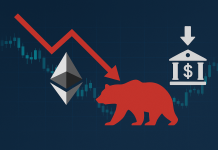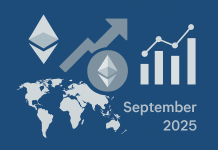Introduction
As the Ethereum ecosystem moves closer to the highly anticipated Pectra upgrade, one of the more noticeable trends in April 2025 has been a marked decline in Ethereum’s spot trading volume across major exchanges. This development has drawn the attention of analysts, investors, and market watchers alike, with many questioning what this means for the short- to medium-term price trajectory of ETH. Could the recent dip in volume be a sign of healthy consolidation ahead of a breakout, or is the market signaling weakness and preparing for a broader correction?
This article explores the current dynamics around Ethereum’s trading environment, the implications of the Pectra upgrade, technical analysis insights, investor behavior, and broader macroeconomic indicators to provide a comprehensive view of where Ethereum may be headed next.
Understanding The Pectra Upgrade: What It Means For Ethereum?
Scheduled for release on May 7, 2025, the Pectra upgrade represents the next major development milestone for Ethereum. The upgrade is designed to improve the performance, security, and user experience of the Ethereum blockchain through a series of protocol changes. At its core, Pectra will incorporate several Ethereum Improvement Proposals (EIPs), including enhancements to validator efficiency, reduced latency, and better support for Layer 2 networks.
This hard fork is also expected to improve interoperability within the Ethereum ecosystem and decrease congestion issues that have occasionally plagued the network, especially during periods of high demand. These changes are broadly seen as positive for the long-term health and utility of the Ethereum network.
Yet despite these clear technical benefits, the market’s short-term reaction has been muted, as evidenced by subdued trading activity and a lack of momentum in price action throughout the month of April.
Ethereum Spot Volume Trends: A Steep Decline Across Major Exchanges
According to market data aggregated by leading analytics platforms, Ethereum spot trading volume decreased by nearly 40% during the month of April compared to March 2025. Centralized exchanges like Binance, Coinbase, and Kraken all reported double-digit percentage drops in ETH trading activity. Similarly, decentralized exchanges (DEXs) like Uniswap and Sushiswap experienced notable slowdowns in ETH transaction throughput.
This drop in volume is particularly interesting because it contrasts sharply with expectations leading up to a major protocol upgrade. Typically, such upgrades are accompanied by increased speculation, buying pressure, and heightened trading activity. Instead, April presented a calmer, more cautious Ethereum market—raising questions about investor sentiment.
Consolidation Or Complacency: What Analysts Are Saying?
Analysts remain divided on what this drop in volume means. One school of thought suggests that the Ethereum market is currently consolidating, and that this quiet phase may be the calm before a storm—potentially a bullish breakout if the Pectra upgrade is successful and network performance improves noticeably. According to this viewpoint, the market is simply waiting for confirmation of technical progress before resuming upward momentum.
On the other hand, some analysts warn that the reduction in trading activity could signal growing investor complacency or even preparations for a “sell-the-news” event, where traders exit positions once the anticipated upgrade is complete. This risk is not unfounded; Ethereum has seen similar behavior during past network upgrades where price initially rose on anticipation and then corrected sharply post-deployment.
Adding complexity to this analysis is the broader crypto market environment, which has remained largely range-bound throughout Q2 2025. With Bitcoin stuck in the $63,000–$68,000 range and altcoins showing mixed performance, Ethereum’s lackluster volume may simply reflect an overarching trend of reduced risk appetite.
On-Chain Metrics: Investor Behavior And Whale Activity
To gain deeper insights into market sentiment, it’s useful to look at on-chain data. In April, Ethereum’s active address count and daily transaction volume both trended slightly downward. More telling, however, is the recent slowdown in whale accumulation. Data from Glassnode and Nansen shows that wallets holding over 10,000 ETH were net neutral or even slightly reducing exposure in the days leading up to the Pectra upgrade announcement.
This behavior suggests that large investors are adopting a wait-and-see approach, possibly reflecting uncertainty around the market’s next direction. Retail investor activity, on the other hand, has remained relatively stable, with no major spikes in new wallet creation or transactional activity.
Interestingly, Ethereum’s staking participation has continued to increase, signaling strong long-term confidence in the network. Over 30 million ETH are now staked, locking up a substantial portion of the circulating supply and reducing available liquidity on exchanges. This factor may play a key role in shaping price dynamics after the upgrade.
Technical Analysis: ETH In A Holding Pattern
From a technical perspective, Ethereum’s price action throughout April has been marked by sideways consolidation. ETH has traded within a narrow range between $3,200 and $3,600, with multiple failed attempts to break above resistance at the $3,700 level. Support has held relatively well around the $3,100 zone, but bearish momentum has not completely dissipated.
Key technical indicators like the Relative Strength Index (RSI) and Moving Average Convergence Divergence (MACD) are currently in neutral territory, offering little directional bias. Ethereum’s 200-day moving average has acted as dynamic support, suggesting that long-term bullish structure remains intact—at least for now.
Volume profiles also indicate a lack of conviction on either side of the market, further supporting the idea that ETH is waiting for a catalyst—which may very well be the Pectra upgrade—to determine its next major move.
Broader Market Influence: Macro Trends And Regulatory Overhang
Beyond Ethereum-specific developments, the broader macroeconomic environment continues to exert influence over crypto markets. April brought renewed concerns about U.S. Federal Reserve policy, particularly around inflation data and interest rate expectations. A stronger-than-expected inflation print caused a brief risk-off sentiment across global markets, spilling into the crypto space.
Regulatory uncertainty also lingers, especially in the United States where the Securities and Exchange Commission (SEC) is actively pursuing enforcement actions against several crypto projects. While Ethereum itself has largely avoided regulatory scrutiny, the overall sentiment toward digital assets remains cautious.
The potential approval or rejection of Ethereum ETF proposals pending before the SEC could also play a pivotal role in determining ETH’s next move. Although there were no major updates in April, developments in May could quickly shift investor sentiment.
Conclusion
As Ethereum prepares for the Pectra upgrade on May 7, the market seems to be in a state of suspended animation. On one hand, the significant drop in spot trading volume may simply reflect a temporary pause in activity as investors assess upcoming developments. On the other, it could be a subtle warning sign of reduced enthusiasm and potential downside risk if the upgrade fails to generate expected network benefits or spark renewed buying pressure.
For long-term holders, Ethereum’s fundamentals remain strong. The upgrade is likely to enhance scalability and drive future growth in decentralized applications and Layer 2 integrations. However, short-term traders should be cautious, keeping a close eye on volume trends, on-chain activity, and external market conditions.




